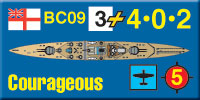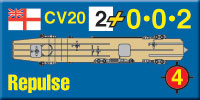Plan Z: Battle Cruisers
Battle Cruiser Conversions
by Mike Bennighof, Ph.D.
November 2021
The Royal Navy laid down three strange and fairly useless “large light cruisers” of the Courageous class in 1915, and completed them in 1917. They were very long, very fast, and very lightly built. Two of them (Courageous and Glorious) carried four 15-inch guns in pair of double turrets sited fore and aft; their near-sister Furious had at first two single 18-inch guns, later reduced to one to accommodate aircraft facilities, then reduced to none to allow more aircraft-handling room.
 The Washington Naval Limitations Agreement allowed the major-power signatories to convert 66,000 tons’ worth of surface ships to aircraft carriers. The United States and Japan chose to rebuild two battle cruiser hulls of roughly 33,000 tons apiece (once completed as carriers). The British had held out for the 66,000-ton figure because it would allow them to convert all three of the light battle cruisers. The Washington Naval Limitations Agreement allowed the major-power signatories to convert 66,000 tons’ worth of surface ships to aircraft carriers. The United States and Japan chose to rebuild two battle cruiser hulls of roughly 33,000 tons apiece (once completed as carriers). The British had held out for the 66,000-ton figure because it would allow them to convert all three of the light battle cruisers.
Britain did extremely well out of the Washington conference. Unable to afford new naval construction, she managed to swap cancellation of what today would be called vaporware projects (the huge N3 and G3 ships) for actual scrapping of American and Japanese vessels already under construction. Where Japanese and American taxpayers took a hit for these sacrifices, their British counterparts lost nothing. And they also finagled the carrier conversion limit to their advantage: neither rival had ships in the proper size categories to squeeze three carriers out of the limit.
In their carrier guise, those ships have appeared or will appear in Second World War at Sea games, and modernized versions of the carriers Courageous and Glorious can be found in Plan Z. But what about modernized versions of the ships in their original battle cruiser format, rebuilt like the other older ships for service in the Second Great/World War? In Plan Z: Battle Cruisers, we present them as battle cruisers, in modernized form.
 I had assumed they might make potent fast escorts for carrier task forces, but like other British ship designs they had rather crowded upper decks. There’s enough room for five of the dual 4.5-inch anti-aircraft mounts used in the rebuilding of Renown, plus some 2-pounder pom-pom mounts for close defense. They retain their main armament: four 15-inch guns for Courageous and Glorious, two 18-inch guns for Furious. They have a new bridge structure similar to that given Renown during her 1936-39 reconstruction. I had assumed they might make potent fast escorts for carrier task forces, but like other British ship designs they had rather crowded upper decks. There’s enough room for five of the dual 4.5-inch anti-aircraft mounts used in the rebuilding of Renown, plus some 2-pounder pom-pom mounts for close defense. They retain their main armament: four 15-inch guns for Courageous and Glorious, two 18-inch guns for Furious. They have a new bridge structure similar to that given Renown during her 1936-39 reconstruction.
The light battle cruisers had been constructed with better turbines than those of Renown and Repulse, and so the rebuilt versions retain that part of their power plant. Like Renown, they’ve received new and much more efficient (and smaller) Admiralty three-drum boilers. That change would have allowed for improvements to their protection scheme, since the new boilers took up less space than the old, but they would have remained extremely vulnerable to underwater damage. And to just about every other kind of damage as well.
 As in the Japanese and U.S. navies, the converted battle cruisers set the standard for aircraft carrier size; Britain built much smaller fleet carriers than did her rivals. But she had other battle cruisers that could have been converted, either in place of the light battle cruisers to yield larger carriers or in addition to them had the Washington agreement differed in its particulars. As in the Japanese and U.S. navies, the converted battle cruisers set the standard for aircraft carrier size; Britain built much smaller fleet carriers than did her rivals. But she had other battle cruisers that could have been converted, either in place of the light battle cruisers to yield larger carriers or in addition to them had the Washington agreement differed in its particulars.
As aircraft carriers, Repulse and Renown would have been somewhat larger than Courageous, allowing them to operate a larger air group (probably 60 planes compared to 48 for the smaller ships). In our Dragon Boat set they’ve been constructed similarly to Courageous but larger (you can tell if you look closely at their drawings).
 Hood, on the other hand, was a much larger battle cruiser and would have made for a much larger carrier. Like Renown she follows a similar pattern to Courageous, but her greater length allows for additional galleries of anti-aircraft weapons, and combined with her broader beam would have allowed a bigger air group – probably 72 planes. “The Mighty Hood” would have lived up to her press clippings in aircraft carrier guise; she would have been roughly the same size as the American carrier Lexington. Hood, on the other hand, was a much larger battle cruiser and would have made for a much larger carrier. Like Renown she follows a similar pattern to Courageous, but her greater length allows for additional galleries of anti-aircraft weapons, and combined with her broader beam would have allowed a bigger air group – probably 72 planes. “The Mighty Hood” would have lived up to her press clippings in aircraft carrier guise; she would have been roughly the same size as the American carrier Lexington.
And then we have American carriers. The U.S. Navy converted two battle cruisers of the Lexington class and scrapped the hulls of the other four. The two carriers made for huge and very fast ships, but were not really designed to maximize their air power and only carried 63 planes in the 1930’s. Since we had a new drawing for Lexington with her original battery of eight 8-inch guns in four deckside turrets (crafted for the new Midway Deluxe game), it only seemed right to provide pieces for the four other battle cruisers in carrier form.
 The U.S. Navy regarded their big battle cruisers as a flawed design, and even before the Washington conference had looked at alternative plans to convert at least one of them (most likely Ranger) to an aircraft carrier. Six of them converted at once would have been an enormous increase for the fledgling carrier air arm, which could not have manned their air groups, so it’s probably more likely that the hulls would have been laid up incomplete with another pair converted in the late 1920’s and the last pair in the early 1930’s. The U.S. Navy regarded their big battle cruisers as a flawed design, and even before the Washington conference had looked at alternative plans to convert at least one of them (most likely Ranger) to an aircraft carrier. Six of them converted at once would have been an enormous increase for the fledgling carrier air arm, which could not have manned their air groups, so it’s probably more likely that the hulls would have been laid up incomplete with another pair converted in the late 1920’s and the last pair in the early 1930’s.
Naval tactical and operational doctrine would surely have evolved in a radically different manner during the 1920’s and 1930’s had Britain and the United States each operated six large flattops during that period (as one has to image that the Japanese would have followed suit with more big carrier conversions of their own). The Second World War would have been a carrier war from the start, with battleships relegated to escort duties and many of the older ships likely scrapped rather than undergoing expensive modernizations.
Plan Z: Battle Cruisers is a fun little set of alternative pieces, and we’ve included some scenarios for their use.
The Plan Z: Battle Cruisers expansion is free for Gold Club members.
Click here to join the Gold Club right now!
Sign up for our newsletter right here. Your info will never be sold or transferred; we'll just use it to update you on new games and new offers.
Mike Bennighof is president of Avalanche Press and holds a doctorate in history from Emory University. A Fulbright Scholar and NASA Journalist in Space finalist, he has published more books, games and articles on historical subjects than anyone should.
He lives in Birmingham, Alabama with his wife, three children, and his Iron Dog, Leopold.
Want to keep Daily Content free of third-party ads? You can send us some love (and cash) through this link right here.
|
